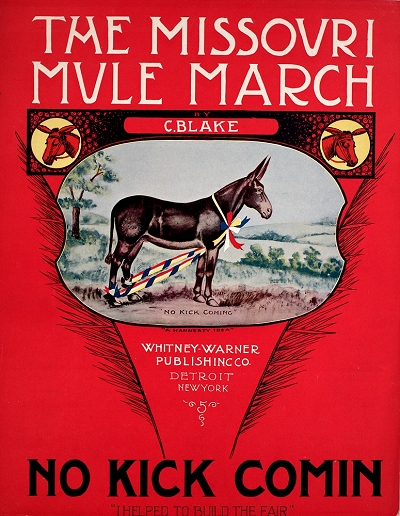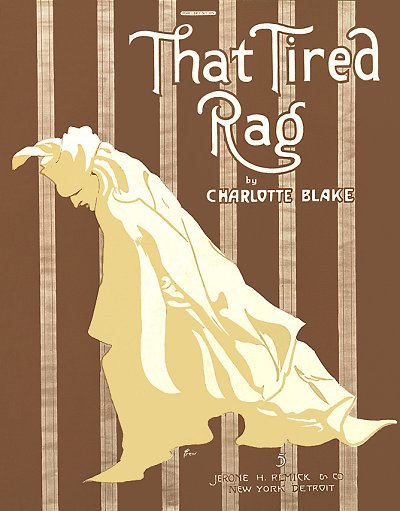 Charlotte M. Blake Wainman (May 30, 1885 to August 21, 1979) | |
 Compositions Compositions | |
|
1903
King Cupid1904
The Missouri Mule March(No Kick Coming) 1905
Dainty Dames - A NoveletteThe Mascot: March My Lady Laughter: Waltzes 1906
Love Is King: WaltzesCould You Read My Heart? [1] 1907
A Night, A Girl, A MoonCurly: March Two Step Orchids: Novelette Three Step Hip Hip Hurrah: March Jubilee March The Last Kiss: Waltzes I Wonder If It's You? [2] Boogie Man, A Creep Mouse Tune So Near and Yet So Far [1] 1908
Love Tree: WaltzesThe Gravel Rag In Mem'ry of You [1] 1909
That Poker RagHoney When It's Sunny [1,3] It Makes A Lot of Difference When You Are With The Girl You Love [1,4] Yankee Kid The Wish Bone (Rag) Lily Eyes: Valse Poetique |
1910
Honey Bug (I Am Not to Blame) [5]Spoonlight [5] Tenderfoot [5] Bridal Veil - Waltzes You're a Classy Lassie [5] Love Ain't Likin', Likin' Ain't Love [5] Meet Me Half Way Miss Coquette Love's Dream of You [5] Roses Remind Me of You [5] 1911
The Road to Loveland [5,6]I Don't Need the Moonlight to Make Love to You [7] That Tired Rag The Harbor of Love [5] 1913
Queen of the RosesLand of Beautiful Dreams [8] 1915
Rose of the World, Come Back to Me [9]1919
Honey, When It's Money
1. w/Arthur Gillespie
2. w/Vincent Bryan 3. w/Collin Davis 4. w/Harold Ward 5. w/Earle Clinton Jones 6. w/Charles N. Daniels 7. w/Francis X. Conlan 8. w/Maurice E. Marke 9. w/Richard W. Pascoe |
Charlotte M. Blake was born in Franklin County, Ohio, to Edward C. Blake and Caroline P. Graves, both natives of the state, within a year of the couple's marriage. She was the oldest of six siblings, including Harry Franklin (8/31/1887), Marguerite L. (3/1891), Fenimore Cooper (4/24/1893), Benjamin S. (5/26/1895-3/26/1907), Laura J. (9/1898) and Martha V. (1903). Benjamin did not survive to adulthood. The family appears in the June 1900 enumeration living in Grove City Village, a suburb of Jackson, Ohio, located near Columbus. Edward was listed as a "commercial traveler." However, they had moved to Michigan, where Martha was born, by 1903.
Charlotte started her professional musical career in 1903 at age 18, working initially as a clerk, then later as a staff writer, arranger and music demonstrator for Whitney Warner Publishing in Detroit, Michigan, which would soon be folded into the firm of publishing giant Jerome H. Remick. She turned out to be a fairly prolific composer for the publisher turning out a reported 35 titles, many of them marches and waltzes. This was done initially without recognition of her gender to the general public. Even Detroit city directories of that time show Charlotte's occupation as merely "clerk" or "pianist."

Early acknowledgments in publicity, trade magazines, and on sheet music covers, although generous in their prominence, listed her as C. Blake until she was 21. It was then that her full name was revealed on her music and in ad copy from Remick that read as follows:
"Dainty Dames" Novelette: This beautiful, little, dainty semi-classic by Charlotte Blake stands out prominently with the very best class of leaders and is played continuously. It is called a Novelette and certainly is novel in every sense of the word, and exceedingly melodious. Especially adapted for Theatre and Concert work and is a most catchy Schottische.
A typical announcement from 1907 read: "Jerome H. Remick & Co., music publishers, are exploiting a new march two-step, "Curly," written by Miss Charlotte Blake. The piece has just come off the press." Also that same year, the Chicago Tribune gave Charlotte and other female composers their due in an article printed on November 17, 1907, but it was also highly indicative of the contemporary roles and expectations of the sexes in general:
Woman has invaded another field in which man thought he was supreme. She has become a writer of popular songs and instrumental numbers, and many of the most tuneful and affecting ditties of the day are written by women…
Miss Charlotte Blake of Detroit, Mich., although she has been writing popular music for only a short time, has established a reputation that most any of the men song writers might envy. She unquestionably is the most prolific and versatile of the many women composers. "Dainty Dames," a novelette for the piano, is undoubtedly her best number. "My Lady Laughter" and "The Last Kiss," both waltzes, are in demand. Her latest number is a "rag," entitled "Curly." Two songs from Miss Blake's pen which bid fair to be successes are "Could You Read My Heart" and "I Wonder If It's You."…
Her latest number is a "rag," entitled "Curly." Two songs from Miss Blake's pen which bid fair to be successes are "Could You Read My Heart" and "I Wonder If It's You."…
 Her latest number is a "rag," entitled "Curly." Two songs from Miss Blake's pen which bid fair to be successes are "Could You Read My Heart" and "I Wonder If It's You."…
Her latest number is a "rag," entitled "Curly." Two songs from Miss Blake's pen which bid fair to be successes are "Could You Read My Heart" and "I Wonder If It's You."…Although the women may have just as much talent as the men, it is not to be expected that their songs and music numbers ever will become as genuinely popular as are those of the men. The men have this advantage: For the purpose of "plugging" (a term used by the profession for popularizing) their new creations, they can go where they please, when they please, and stay out as late as they please without shattering any of the traditions of propriety. The women, however, cannot do this.
Imagine a woman song writer standing at a stage door until she can converse with some masculine performer and impress upon him that she has the one song that will "make his act." Imagine her running around until 1 o'clock or later in the morning leaving orchestrations of her latest with the orchestra and piano players of the good, bad, and indifferent cafés.
She can't do it, and it isn't expected of her. These are but two of the many things she can't do to "push" her song. Of course her work is placed ultimately where it will do the most good, but it isn't given the close attention the men can pay to their own screeds.
Despite these handicaps, however, the writings of women song makers are growing more popular with each succeeding year, and it is only a question of a little while when their work will stand on an equally sound footing with the ditties of the men.
As stated above despite the alleged handicaps that her gender reportedly served her, and her obvious talent at composing songs and waltzes, Charlotte showed a propensity for syncopated ragtime as well. She composed her two most famous rags, Gravel Rag and That Poker Rag, in 1908 and 1909 respectively. In the 1910 census Blake is listed as a music composer, but still residing with her family in Detroit City. Her father was now in the wholesale fur trade as E.C. Blake & Company, "Dealers in Raw and Dressed Furs."
Around 1911 Blake wrote her last rag, followed by a series of songs and waltzes over the next several years. That Tired Rag elicited the following review in the American Musician and Art Journal:
With "rags" in general we are at enmity, and we pour out the vials of our wrath on the ragger who invented rag. But seeing that "rags" are on the market we must acknowledge them. As a sample of the peculiar king, Charlotte Blake's "That Tired Rag" is as good as any of them.
One of her best sellers was the romantic song The Harbor of Love. Published music by Blake ceased nearly altogether by 1916, when she had evidently retired from composing. One more song reportedly appeared in 1919, although it is hard to verify Honey, When It's Money.
One more song reportedly appeared in 1919, although it is hard to verify Honey, When It's Money.
 One more song reportedly appeared in 1919, although it is hard to verify Honey, When It's Money.
One more song reportedly appeared in 1919, although it is hard to verify Honey, When It's Money.The disappearance from the music business may have had something to do with a marriage that until now has not been indicated in sources with any information on Charlotte. During a stay in Manhattan, New York, she was married to Kenneth Bruce Wainman on October 28, 1912. Born in New York from Canadian parents, the 1910 census showed him to be a piano store salesman living in Rochester, New York. It appears that the couple resided in New York City for a few years. In 1917, Bruce enlisted in the new Army Air Corp, serving overseas from August of that year to April of 1919. Little more information was found on Bruce beyond that, but this may be the period of time during which they split up. Bruce would remarry in Indiana in 1924, and again in California in 1935, dying in Los Angeles in 1937.
Charlotte cannot be readily located in the 1920 census under either last name. Her mother Caroline, now widowed, had moved to Buffalo, NY, to live with Charlotte's sister Laura by the time of the 1920 record, but was back in Detroit before 1930. She and Charlotte shared an apartment in that city at a couple of locations between 1930 and 1932. Her status in 1930 showed her as divorced and living with her Caroline, and her last name still as Wainman. She soon took back her maiden name. Caroline died in the early 1930s, and before 1935 (assuming she gave the 1940 enumerator the correct information) Charlotte had relocated to Hollywood, California. She was found there for the 1940 census living in an apartment at 1736 North Orange Drive just north of Hollywood Blvd with no occupation listed. The California voter records for 1940, 1942 and 1944 generically listed her as a housewife.
Likely beginning after America entered World War II, Charlotte worked for some 20 years at Douglas Aircraft Corporation as a clerk. Just the same, the 1950 census found her living with "partner" and fellow divorcée Kathrine Eagle, neither of them showing an occupation. Remaining in Hollywood until at least the 1950s, she eventually relocated west to nearby Santa Monica. After retirement Charlotte stayed in Santa Monica until her death in 1979 at age 94, and her status on the death certificate also indicates that she was divorced, most likely the same event from the early 1920s.
Charlotte Blake's rags demonstrate a direct and studied approach to composition, making certain that the individual components fit together, and they show inherent cleverness and a sense of humor as well. That Poker Rag and That Tired Rag in particular demonstrate her talents with both melody and cohesive continuity. She also wrote many songs while in the employ of Remick, though they have been mostly forgotten. Charlotte was mostly forgotten until the mid-1970s when performer Max Morath recorded his legendary The Ragtime Women album, giving That Poker Rag new exposure, and revealing to the ragtime revival consumers the talents of many women composers, especially Ms. Blake and her peers from the Midwest. In the 21st century select works of hers are performed often at festivals an on recordings.


 View More Female Composer Biographies
View More Female Composer Biographies